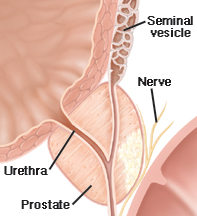Prostate Cancer: Radical Prostatectomy
Prostate Cancer: Radical Prostatectomy
Radical prostatectomy is surgery to remove the entire prostate. It may be done if tests show that the cancer is confined to the prostate. Your surgeon will give you detailed instructions on getting ready for surgery. After surgery, you’ll be told how to care for yourself at home as you recover. Be sure to ask any questions you have about the procedure and recovery.
Risks and possible complications
All surgeries have risks. The risks of this surgery include:
Blood clots
Excess bleeding
Hole (perforation) in the bowel
Infection
Loss of bladder control (incontinence)
Lung infection (pneumonia)
Trouble getting or keeping an erection (erectile dysfunction)
Trouble urinating
Getting ready for your surgery
Follow all instructions from your healthcare team. In addition:
Tell your healthcare provider about all medicines you take. This includes herbs and other supplements. It also includes any blood thinners, such as warfarin, clopidogrel, or daily aspirin. You may need to stop taking some or all of them before the surgery.
You may be told to use a laxative, enemas, or both before the surgery. This is to empty the colon and rectum of stool. Follow the instructions you are given.
Don’t eat or drink after midnight the night before surgery.
How the surgery is done
The surgery may be done through several small incisions in the abdomen. This is called laparoscopy. In many cases, a method called robotic-assisted laparoscopy is used. The robotic system helps during the surgery. It gives a 3-D view of inside the body. It also assists the surgeon’s hand movements.
In some cases, the surgery may be performed through a larger incision in the abdomen. This is called the retropubic approach. Or surgery may be done through an incision behind the scrotum. This is called the perineal approach.
During the surgery:
The surgeon may remove and check the lymph nodes near the prostate. This is to see if cancer has spread. If the cancer has spread, the surgeon may decide not to remove the prostate.
The prostate, seminal vesicles, and a portion of urethra will then be removed.
Nerve-sparing methods may be used to try to preserve erectile function.
After surgery
You will have a catheter in place to drain urine from your bladder. Urine will flow through the catheter into a sterile bag. The urine may be bloody or cloudy at first. You may go home in 1 to 3 days.
Recovering at home
You’ll be given medicines to control pain. The catheter will be left in place when you go home. You’ll be given instructions on how to manage it.
Follow-up care
The catheter and stitches will be removed at a follow-up visit. This is often 1 to 2 weeks after surgery. Bladder control often takes a few weeks to several months to return. Improvement can continue for up to a year.
When to call your healthcare provider
Call your healthcare provider right away if you have any of the following:
Chills
Fever of 100.4°F (38°C) or higher, or as directed by your healthcare provider
Fluid leaking from your incision
Redness or pain in the incision that gets worse
Swelling of your leg or ankle
Trouble urinating after the catheter has been removed
Urine not draining from the catheter
Updated:
May 29, 2017
Reviewed By:
Alteri, Rick, MD,Gersten, Todd, MD

